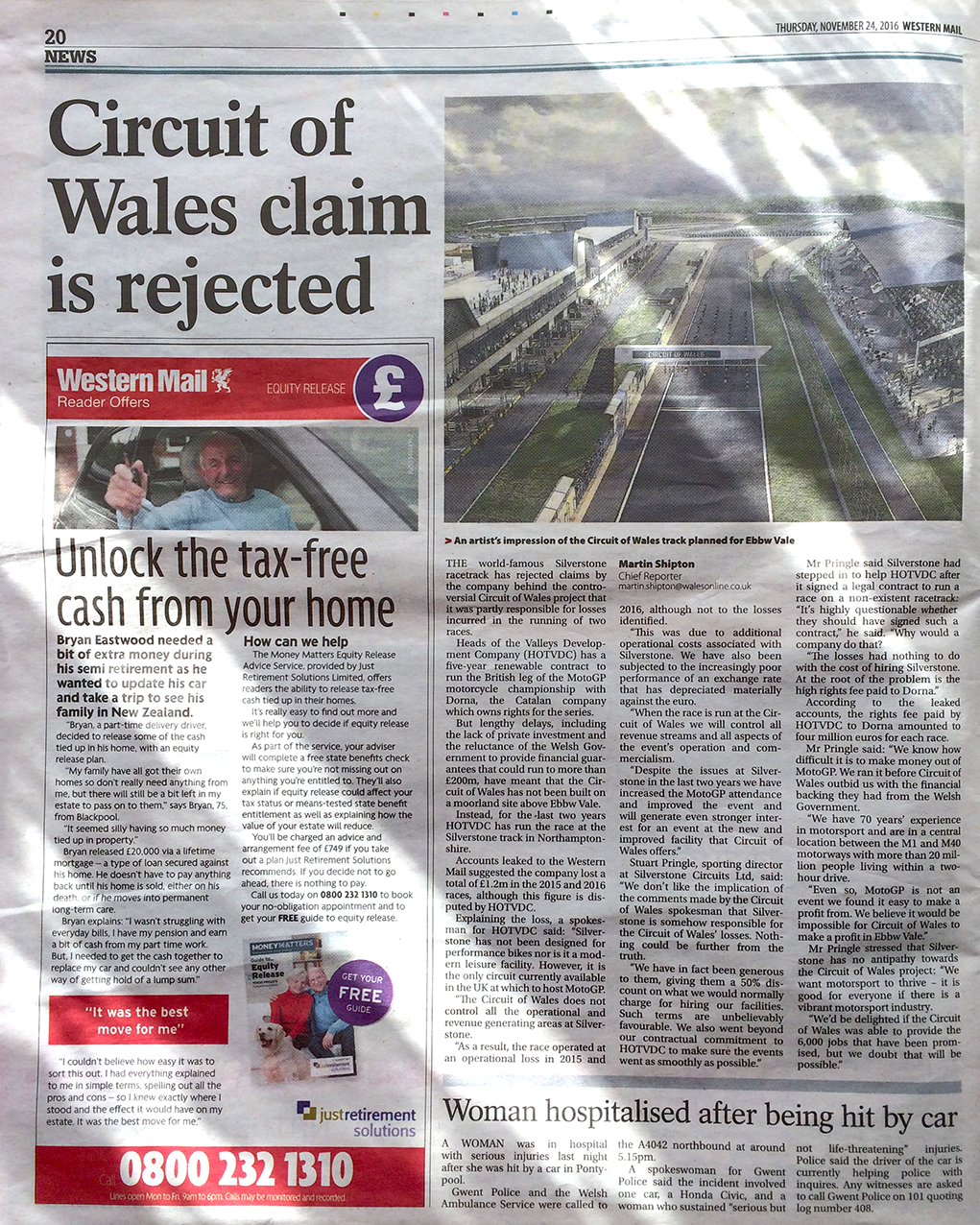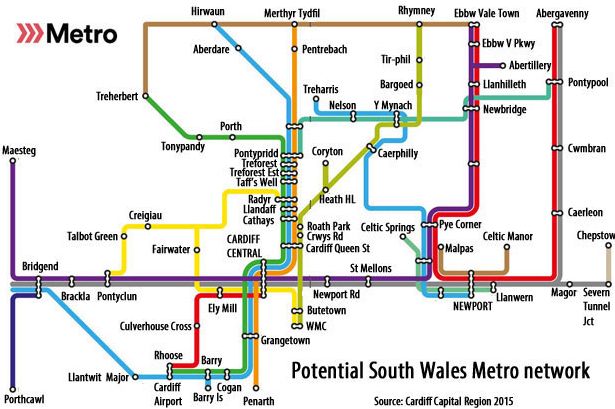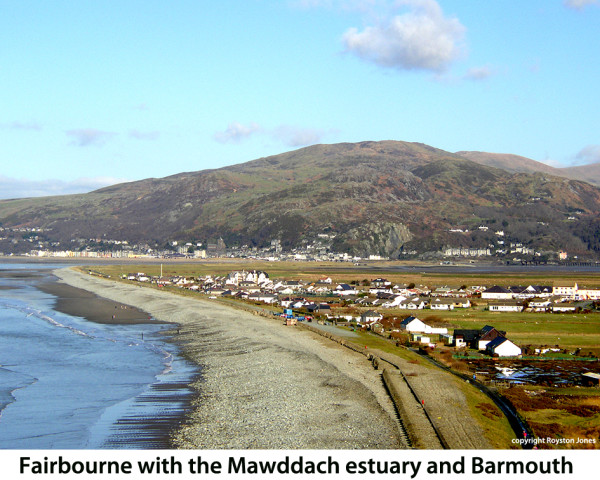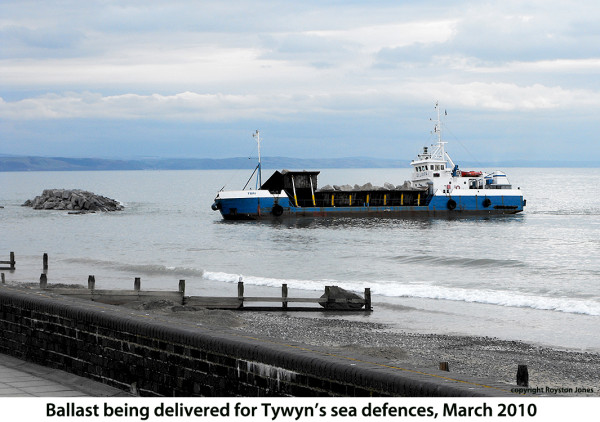When I first heard of the Circuit of Wales project back in the early part of 2013 I was somewhat sceptical of its chances of success, and the reasons for my scepticism were set out in Vroom, Vroom – The Next Gravy Train?
Despite being doubtful that the project would ever materialise I was (in the even-handed manner for which I am rightly acclaimed) also critical of some of those raising objections to the CoW, not least the environmentalists who seem to oppose anything that might benefit those who live permanently in Wales.
For various reasons that I don’t have the space to analyse here, the project has ‘drifted’ somewhat since my original post, and in recent weeks we have witnessed attacks on the Heads of the Valleys Development Company (HOTVDC) and its Circuit of Wales from what might, at first sight, appear to be unconnected sources. So let’s look at these attacks and see if we can make sense of them.
♦
A long-time critic of what could be the economic salvation of the region is Conservative MP David Davies, who represents the neighbouring constituency (to Ebbw Vale) of Monmouthshire, perhaps the most affluent area in the country. It’s reasonable to assume that those who vote for Davies don’t want anything noisy on their doorstep, attracting people who will drive through their area to get to the circuit. So while not wishing to be unfair – for there may indeed be more to it – I suspect that nimbyism with a dash of snobbery lies behind the attacks from that direction.
But as I say, Davies, chair of the Welsh Affairs Committee at Westminster, has been a consistent critic, and no doubt he’d argue that he’s just doing his job. And his job has been made easier for him by some strange spending of the millions already invested by the ‘Welsh’ Government.
But the criticism of this project comes from beyond leafy Monmouthshire and its well-heeled inhabitants, from those who cannot be dismissed as nimbys or snobs.
On November 1, after regular sniping from its news broadcasts, BBC Wales made a frontal assault using its Week In Week Out series with A Safe Bet? (Video available here for a while.) There was little pretence at impartiality. Anyone watching this programme with no knowledge of Wales, and how it works, would have concluded that the Circuit of Wales is a complete waste of money and should be ditched immediately.
I admit that Michael Carrick, the man behind HOTVDC, doesn’t always instill confidence, and he has certainly made mistakes. Even so, it appears to me that critics have too often been playing the man rather than the ball. By which I mean, the project needs to be considered on its merits; after all, Einstein being a philanderer didn’t undermine his Theory of Relativity.
♦
The attacks have continued, culminating today in a front page lead continued on page 2 plus an editorial in the Wasting Mule. All written by my old mucker, Martin Shipton.
The justification for today’s attack seems to be that the HOTVDC used the Silverstone circuit in England in 2015 and 2016 to host MotoGP races that it had contracted to host at the Circuit of Wales, and had lost money. Now with the best will in the world, I detect an element of having your cake and eating it in this criticism.
Because those attacking the HOTVDC for making a loss at Silverstone – due to the Circuit of Wales not being completed – are the very same people who have been doing their very best to derail the CoW project altogether!

As for losing money by going to Silverstone, even before reading the response from the HOTVDC I knew the answer. The owners of the Silverstone circuit creamed off the profits, from the hot dog stands to the champagne hospitality suites and from the Ducati baseball caps to the sales of £300 leather biker boots.
A child could work that out, and a younger sibling could add that those profits would have accrued to Ebbw Vale if the Circuit of Wales had been operational, as would other benefits to the area from those visiting for a few days.
God Almighty! Break somebody’s leg and then criticise him for limping.
♦
So how do we account for this recent onslaught from BBC Wales and the Wasting Mule? I suspect there are two, linked, answers.
First, just last month, it became clear that the project had a good chance of proceeding without needing to be underwritten by the ‘Welsh’ Government. Even so, this report from WalesOnline still manages to put a negative spin on the news with, “However, without approval on underwriting from the Welsh Government, the project will effectively be dead as there is little private sector appetite to take a 100% risk exposure position.”
Though I’m a little nonplussed by the phrase “approval on underwriting”. If the writer means underwriting, why not just say that rather than employ such a convoluted phrase? Though with heavyweight backing from Aviva and Kleinwort Benson underwriting from the ‘Welsh’ Government may no longer be needed . . . and it may be this realisation that has triggered the recent attacks.
The article in question was written by Siôn Barry, of whom I shall have more to say in a moment.
Second, if the Circuit of Wales goes ahead then it will challenge the thinking behind the Cardiff Capital Region project. Which, in its simplest terms, is as follows: As many jobs as the Region’s architects can get away with are to be concentrated in Cardiff, as are the Region’s sporting, recreational, cultural and other facilities. So that people from the Valleys will come into Cardiff to earn their crust, and they will come back into Cardiff to be regularly relieved of a great part of that crust.
Which makes it anathema to those behind the City Region that places like Ebbw Vale should be allowed anything as grand as a race circuit, ‘Bloody hell, people will go there spending their money rather than going into Cardiff. Where will it end? They’ll all want something!’
Now the Wasting Mule, despite its hyperbolic claim to be ‘The National Newspaper of Wales’, is, as we all know, a Cardiff newspaper, and the mouthpiece of those seeking to enrich the city at the expense of the rest of Wales. This explains today’s editorial.
The Wasting Mule does not want the Circuit of Wales to progress even if it has 100% private funding, for fear it might limit Cardiff’s ability to enjoy the full benefits of the City Region scam.
Consequently, the final paragraph of Shippo’s editorial is a direct appeal to his friends in the ‘Welsh’ Labour Government to put obstacles in the way of HOTVDC, perhaps to use environmental or other planning ruses. We can be sure that representations are also being made through more ‘private’ channels.
♦
Fundamental to the Cardiff Capital Region project is the Metro system – for how else are people from Merthyr, Ebbw Vale, Maesteg and other outposts of the empire to reach the City of Milk and Honey? Since 2010 the job of promoting the Metro has fallen to a Mark Barry, some might go so far as to say that the Metro is his idea.
After working for the Welsh Development Agency (2002 – 2003) he has maintained good connections with the ‘Welsh’ Government. Though some might suggest a conflict of interests in the following roles:
- Owner of M&G Barry Consulting (Sept 2009 – Present) His Linkedin profile tells us that M&G Barry Consulting was set up to promote the Metro project.
- Board Advisor for Transport and the Economy for the Cardiff Business Partnership (Oct 2010 – Oct 2013)
- Founder of the private sector Metro Consortium (Aug 2011 – Nov 2013)
- Metro Development Director and Advisor to the ‘Welsh’ Government (Nov 2013 – Jan 2016).
(Though seeing as M&G Barry has been going since September 2009 I would have expected the website to be up and running by now. But then, I suppose it’s not looking for business, it’s a one-trick pony.)
I’m telling you this because of course Mark Dafydd Barry is the brother of Siôn Barry, Business Editor of Media Wales, and this explains Siôn Barry’s regular plugging of his brother’s Cardiff Metro scheme, and of course his hostility to the Circuit of Wales.
Yet another example of the incestuous relationship between politics, business, media and academe in Cardiff is provided by the fact that since April this year Mark Barry has been Professor of Practice in Connectivity at Cardiff University, “Exploring the wider economic and regional benefits of the South Wales Metro”.
Though some might think that’s an odd post – created specially? – for a man who did his degree at Manchester in Physics and The Analysis of Science & Technology and who, for many years after leaving university, worked in software design. In fact, Barry seems to have neither qualifications nor experience in the fields of transport and communications before he was granted his vision of the Cardiff Metro . . . and sold it to his former employers at the ‘Welsh’ Government.
This defence of Cardiff’s interests tells us why the Wasting Mule is hostile to the Circuit of Wales, while BBC Wales’ attitude can be explained by the fact that it has as much claim to being our national broadcaster as the Mule has to being our national newspaper.
♦
The Circuit of Wales is a real test for the ‘Welsh’ Government, in a number of ways.
First, and most obviously, it is a massive project, promising thousands of jobs, in an area that badly needs those jobs and the economic boost they’ll bring to the wider economy.
Second, it is becoming clear that for those who believe Cardiff must be the hub for all investment in the south east the Circuit of Wales poses a challenge, partly of itself, and partly because it might encourage other distant towns to question their allotted status of dormitory settlements.
The issue can’t be funding alone. Certainly not for the ‘Welsh’ Government which, it is rumoured, will give more than £100m so that near-bankrupt Aston Martin can relocate in the Vale of Glamorgan, very near to Cardiff. And then there are the hundreds of millions of pounds squandered on the Third Sector for what often seems to be no other reason than providing jobs for Labour cronies and hangers-on. Communities First, which has spent over £300m would be a good example.
Then there are the hundreds, maybe thousands, of smaller projects that have cumulatively swallowed up more money over the years than Aston Martin, Communities First and all the others we know of. Read this puff from 2013, and then read this from just a few days ago. This project was a non-starter, doomed from the outset – but what the hell, it’s only public money!
What’s worse, is that one of the women involved in this doomed venture, Gill Wright, featured in Ancestral Turf, a post I wrote in September 2014. She belongs to a network of people in the Tywi valley – all of whom seem to be English – who appear to be in competition to dream up ever more ludicrous ‘schemes’ for milking the Welsh public purse. And it works – for they get grant after grant that benefits no one but themselves!
The other woman involved with setting up the Level Crossing Bunkhouse in Llandovery, Jane Ryall, is a ‘social enterprise advisor’. So not only do our funding bodies attract all manner of grant-grabbers to take advantage of the easy money, they also pull in those who are now living off those who are living off the Welsh public purse. And it’s all dressed up as economic activity. What a system!
And how can we forget the land deals that were so beneficial to Sir Gilbert Stanley ‘Stan the Pies’ Thomas yet so damaging to the public purse? For those who need to be reminded, read my posts Pies, Planes & Property Development and the sequel – with the same stars! – Pies, Planes & Property Development 2.
So any reticence on the part of the ‘Welsh’ Government to supporting the Circuit of Wales can’t be due to a fear of wasting public money, or a worry that some malcontents might suggest a lack of financial rectitude. For ‘Welsh’ Labour is inured to such criticism.
The Circuit of Wales offers tangible benefits for thousands of our people and a whole region of our country. Which is why the ‘Welsh’ Government needs to put aside its Cardiff bias, ignore the fact that there may be few sinecures in it for Labour Party cronies, and for once – just once – suppress its suspicion of business and entrepreneurship.
Help it happen!
~ ~ ~ ♦ end ♦ ~ ~ ~
UPDATE 17.11.2016: Would you Adam and Eve it! Shippo has returned to the attack on the Circuit of Wales, and what’s more, now he seems to be having a go at my old mate Neil! Bloody hell! where will this end? (Though I note there was no mention of the Brothers Barry.)
I can’t provide a link because the article doesn’t appear to have been uploaded yet to WalesOnline’s appalling and almost unnavigable website.
UPDATE 24.11.2016: Shippo mounts another attack, this time using a spokesman for the Silverstone circuit.

♦








